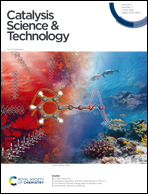Sewage-free preparation of 2D metal oxides by a rapid freezing soft template method for extraordinarily activating solar-driven humidity VOC combustion†
Abstract
Humidity volatile organic compounds (VOCs) cause significant harm to human beings. Two-dimensional (2D) metal oxides exhibit excellent activity towards humidity VOC catalytic combustion. Organic compounds as soft templates have been widely used in the preparation of 2D metal oxides. However, due to the structural fragility of soft templates, the mineralization process is necessary for acquiring 2D metal oxides, which results in the discharge of sewage. Herein, in this study, a novel soft template method based on rapid freezing to generally prepare 2D metal oxides without producing sewage is reported. It is worth emphasizing that the as-synthesized 2D Co3O4 has an 8 nm level of thickness and high specific surface area, which enable it to exhibit high activity towards the combustion VOCs, including formaldehyde, CH4, and acetone, and fully oxidize VOCs to CO2 due to the excellent CO oxidation activity of 2D Co3O4. Further, 2D Co3O4 is added into the light selective absorbing device to obtain a high temperature of 295 °C under 1 sun irradiation. Consequently, 2D Co3O4 shows a nearly 100% combustion efficiency towards humidity formaldehyde, CH4, acetone, and CO under ambient sunlight irradiation, comparable to the corresponding thermal catalytic reactions and far beyond the photocatalytic reactions, showing the potential for practical applications.



 Please wait while we load your content...
Please wait while we load your content...